Butternut Vs Buttercup Squash: What's The Difference
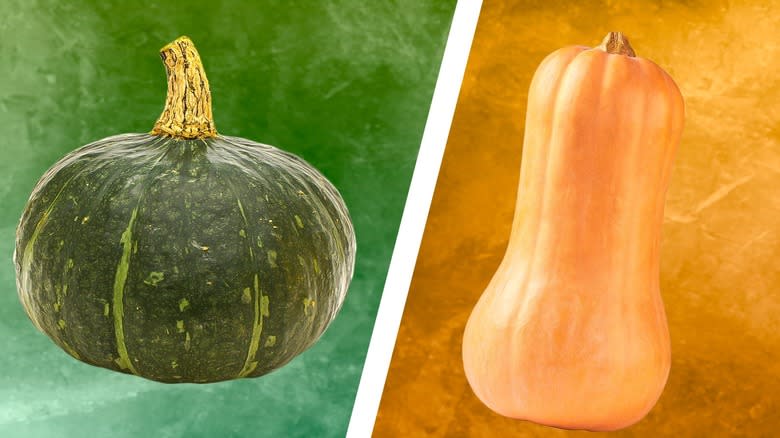
Given the wide selection of squash you can find in the market, it can be confusing to choose the right one for a dish you have in mind. Not only are there distinct differences between summer squash and winter squash, but there are also a lot of varieties falling under each group, particularly the latter.
Unlike what its name implies, winter squash is harvested during autumn, or even late summer. However, due to its tough exterior, this fruit can be kept for months without refrigeration until winter, hence its moniker. Its hard rind is developed through its lengthy growing season, which can be up to 100 frost-free days. With a sweeter and firmer flesh than summer squash, winter squash has made its mark by being featured in plenty of cold-season dishes, from squash casseroles and hearty soups to pies.
Two popular types of winter squash are the butternut and buttercup squash. Although they have similar-sounding names, these two couldn't look any more different from each other, with the buttercup round and green and the butternut elongated and pinky beige. Aside from their physical distinctions, there are also nuanced variations between the two. Find out what these are since these differences can affect not just the flavor but also the texture and consistency of the dishes that you add them to.
Read more: 13 Simple Tricks To Pick The Best Fresh Fruit Every Time
What Is A Butternut Squash?
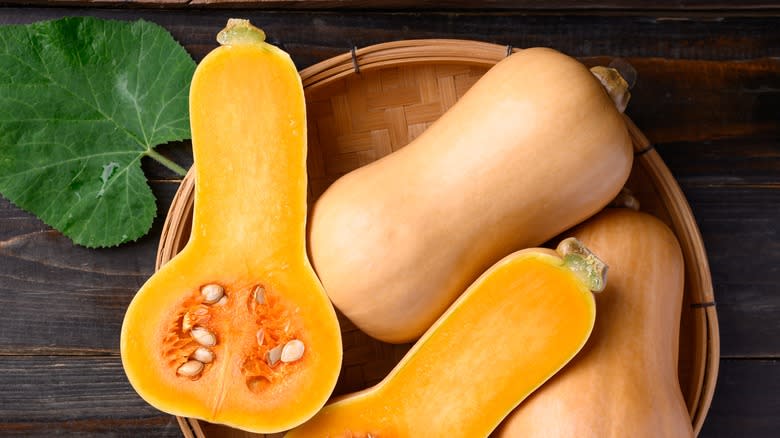
As one of the most popular varieties of winter squash, a butternut squash is very easy to identify. Beneath its smooth pale peel is firm and dense orange flesh, most of which is found within its long, tubular neck. Meanwhile, the bulbous end of this bell-shaped produce contains flat white seeds, nestled within a hollow cavity. The skin of butternut squash can range in color from beige and cream to light yellow and tan, and some people find that it has a mild scent reminiscent of melons when not yet cooked.
Butternut squash is a great source of nutrients, providing an immense amount of vitamin A and also a considerable amount of vitamin C, magnesium, potassium, and manganese. The combination of its fiber and low caloric content also makes it a good addition to a diet plan intended for weight management. The squash's vividly orange flesh is an indication, too, of how rich this fruit is in carotenoids, which have antioxidative properties.
What Is Buttercup Squash?
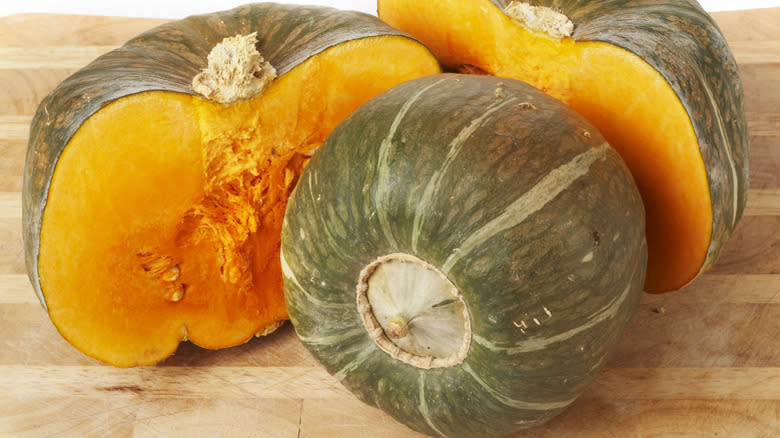
Round and squat, buttercup squash comes with a tough green rind that's often speckled with markings that are either gray or light green. You can also find ridges and narrow stripes running down its sides. When cut open, it reveals thick, dense, and orange-colored flesh. At its center is a hollow cavity containing its flat, light-colored seeds. Like butternut squash, this winter squash variant is a good source of nutrients, including carotenoid antioxidants, vitamins A and C, fiber, magnesium, and potassium.
If you're not too familiar with the name buttercup squash, that could be because it's often mistaken for other types of winter squash. One of them is the kabocha squash, which it resembles in shape, coloring, and markings. To tell them apart, look for a circular ridge at the bottom of the squash; this ridge sometimes has a protruding bump, which gives it the look of a turban. If you find this feature, you've got a buttercup squash. Speaking of a turban-like appearance, another one that it also gets mistaken for is the turban squash, which has a more prominent bump and is traditionally used for decoration as it has vibrant red and orange coloring. All three belong to the Cucurbita maxima species of cultivated squash.
Butternut Squash Flesh Is Easier To Mash And Puree
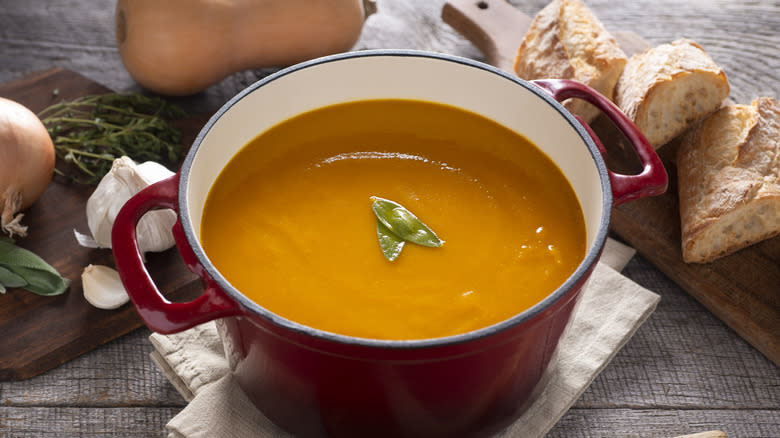
Both types of winter squash are prized for a sweetness that is reminiscent of sweet potatoes and described as having hints of nuttiness. Butternut is generally regarded as the sweetest among the winter squash variants, with its flavor also compared to butterscotch. It helps that its moist flesh is easy to mash and turn into puree, making it quite the versatile and easy-to-cook ingredient. Aside from the usual soups and pasta fillings, you can turn butternut squash into fritters to give it a delectable crunch. You can even add butternut squash to sandwiches to make them heftier and heartier, with a velvety sweetness.
In comparison, buttercup squash has firmer flesh that can dry out further under most cooking methods like sauteing. It comes out best when the cooking method infuses it with moisture, such as when you steam, bake, and roast it, so the flesh becomes soft and creamy. It's also easier to blend into a puree after it has been steamed or roasted. You can cook curries with buttercup squash as well since it can withstand being simmered in a stew for a considerable time while still holding its shape. Because of its less tender texture, swapping it for butternut squash in most dishes isn't recommended.
Buttercup Squash Has Thicker, Tougher Skin
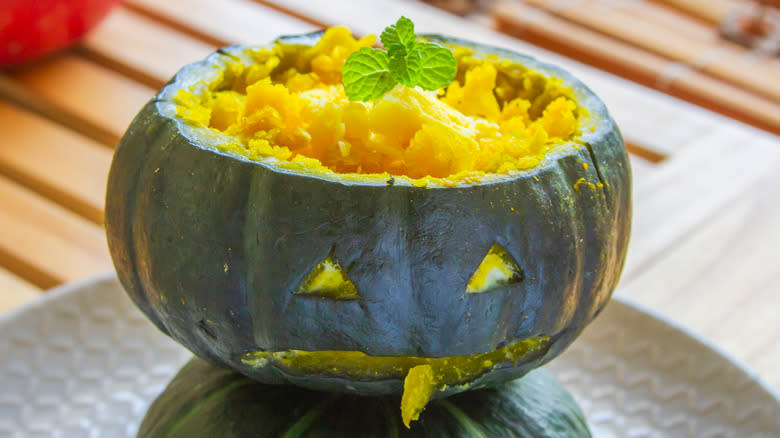
Beyond the visual differences between these winter squash variants' respective rinds, buttercup squash has a tough peel that, while edible and fibrous, might not be pleasant to eat. You can opt out of removing it if you're roasting or steaming the squash but when baking or cooking it in stews, it must be peeled.
Because of the thickness of the rind, using a peeler to remove it would take some time. To speed up the process and also make it safer, you could poke the buttercup squash all over with a fork and place it in the microwave on high heat for three minutes to soften the rind. Afterward, cut off the bump at its bottom to make it flat for easier and safer slicing. You can then halve it, scoop out the seeds, and remove the now-softer skin with a peeler or a knife.
Butternut squash's smoother, thinner rind is easier to remove and more palatable to eat, especially when the fruit is small in size. If you prefer to cook it skinless, a peeler can easily do the trick. Slice off a small portion from both ends first so there's a clear starting and end point as you scrape the peeler against the squash in vertical strips. What you should never skip, though, before peeling and cutting either winter squash variant is washing then drying the produce completely. This keeps any dirt or pesticide residue from getting into the flesh.
Butternut Squash Can Continue To Ripen Off The Vine
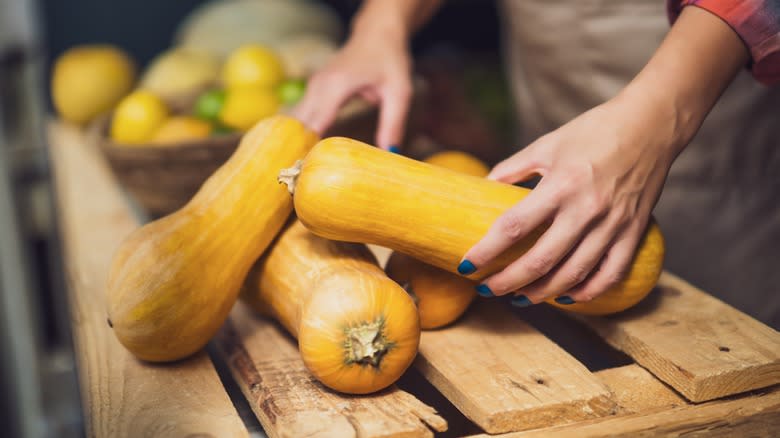
For most fruits, lightly handling them to gauge for softness is a way to check for ripeness; this isn't the case for winter squash. For all of its varieties, a hard rind is an indication of maturity: It should be tough enough to withstand the pressure you apply to it with your thumbnail. Buying one with a tender peel leaves you with a bland and too-starchy product that lacks the buttery sweetness that squash is known for. Another tactile tactic to check for ripeness is tapping on the rind: A hollow sound means it has reached maturity.
If you're buying a butternut squash for a meal you'd like to cook within the week, avoid getting pale-looking ones with an uneven tone on their rind. The deeper the color, the better. The stem should also be dry with a cork-like texture rather than green and tender.
If you can afford to wait, proper storage can help an unripe butternut squash continue to mature even when it's off the vine. Store it dry in an area where the temperature is consistently between 50 and 60 degrees Fahrenheit. Humidity should also be between 50% and 70%, since too much moisture can leave the squash vulnerable to disease while an arid environment can decrease its volume. Create its ideal setting and your unripe butternut squash will reach its optimal state within two months.
Buttercup Squash Must Be Harvested Only When Ripe
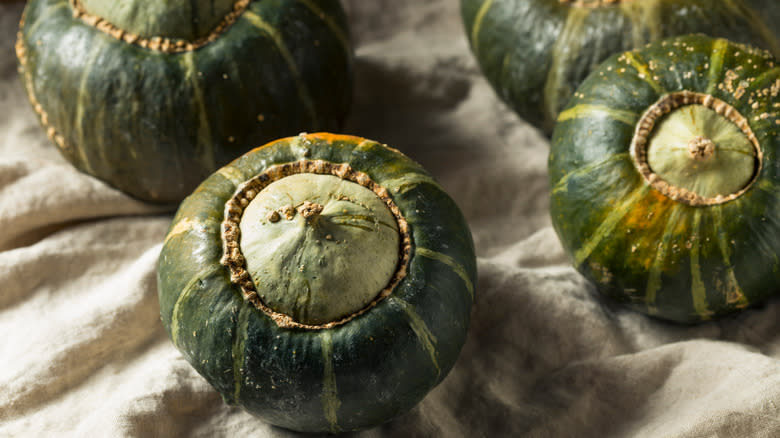
For this winter squash variant, getting picked from the vine halts its ripening process. That is why it's important to check what you're buying for signs of maturity. Aside from doing the tapping test on its rind that we mentioned earlier and checking that its stem has dried out, your buttercup squash should have a deep green peel that's matte rather than shiny. Avoid any that have moldy spots or sunken areas. Check its bump, too, for roundness and firmness. If it feels tender, then the squash is past its prime.
Even though buttercup squash needs to be ripe when picked, it's easy to make it last longer without its quality getting compromised. Store it in a brown paper bag or a cardboard box in an environment that has an average temperature of around 50 to 55 degrees Fahrenheit. It should also be well-ventilated and with a humidity between 50% and 70%. Avoid placing it near other produce that releases the ripening agent ethylene gas, such as bananas, tomatoes, apples, and pears, so it doesn't develop undesirable qualities. Stored properly, your buttercup squash can last from 3 to 6 months.
Read the original article on Tasting Table.


